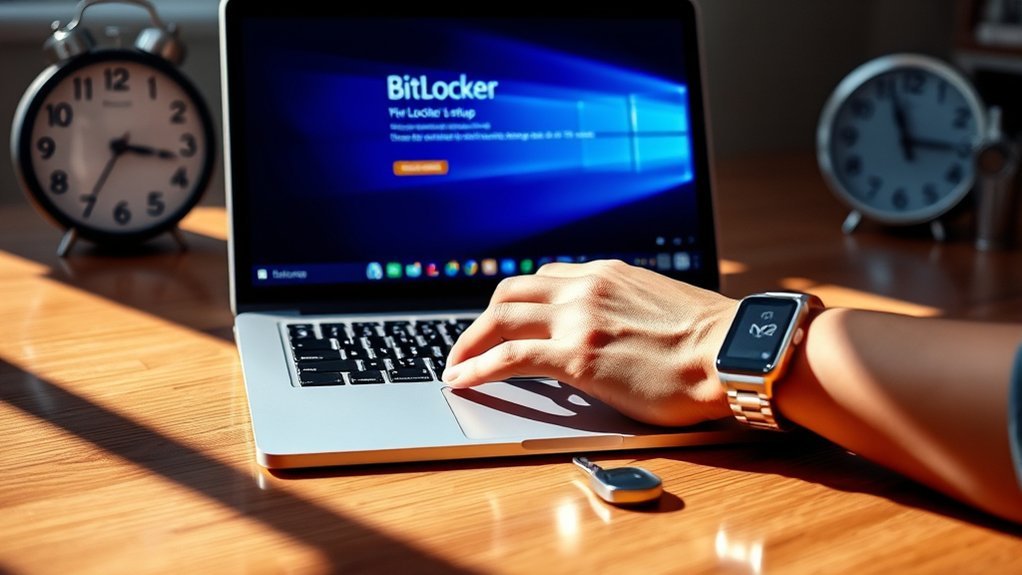Setting up BitLocker on Windows involves verifying system requirements, enabling encryption, and managing recovery options effectively. By following these steps, you can enhance your device’s security and protect sensitive information. However, overlooking even one aspect could lead to vulnerabilities. Understanding how to implement these measures correctly is essential for maintaining data integrity and ensuring peace of mind. Are you ready to secure your device?
Verify System Requirements for BitLocker
Before you can set up BitLocker on your Windows device, you need to verify that your system meets specific requirements.
First, make sure your device runs a compatible version of Windows, such as Pro, Enterprise, or Education. Check that your hardware supports a Trusted Platform Module (TPM) version 1.2 or higher, as it enhances security by storing encryption keys.
If your system lacks TPM, you can enable BitLocker using a USB flash drive, but this method’s less secure. Additionally, confirm that your drive is formatted as NTFS.
Finally, make certain you’ve backed up any essential data—setting up BitLocker can encrypt your drive, potentially leading to data loss if issues arise.
Meeting these requirements will pave the way for a secure encryption experience.
Enable BitLocker on Your Drive
To enable BitLocker on your drive, you’ll need to access the Control Panel or Settings menu on your Windows device. Locate “BitLocker Drive Encryption” and select the drive you wish to protect. Click “Turn on BitLocker” and follow the prompts to choose your preferred authentication method, like a password or smart card.
Here’s a snapshot of the options you’ll encounter:
| Authentication Method | Purpose |
|---|---|
| Password | Secure access to your drive |
| Smart Card | Enhanced security with hardware |
| USB Drive | Portable authentication |
| No Authentication | Not recommended, less secure |
After completing these steps, your drive will be encrypted, liberating your data from unauthorized access. Enjoy the peace of mind that comes with security.
Manage Recovery Options for Maximum Security
While securing your drive with BitLocker is essential, managing your recovery options is equally important for maximizing security.
Start by creating a secure recovery key. Store it in a trusted location, but avoid using cloud storage, which can be vulnerable. Instead, consider using a USB drive kept in a secure spot.
Next, regularly review your recovery options. Confirm they’re up to date, particularly if you change your password or security settings.
Be cautious about sharing recovery information; only share it with trusted individuals.
Finally, familiarize yourself with the recovery process. Knowing how to access your data if locked out can save you from unnecessary stress.
Prioritizing these steps empowers you to maintain control over your encrypted drive.
Frequently Asked Questions
Can I Use Bitlocker on External Drives?
Yes, you can use BitLocker on external drives. It encrypts your data effectively, ensuring your files remain secure. Just connect the drive, enable BitLocker, and follow the prompts to protect your information easily.
Does Bitlocker Affect System Performance?
BitLocker can slightly impact system performance—around 5-10% during heavy encryption tasks. However, for most users, this is negligible compared to the enhanced security it offers, empowering you to protect your data effectively.
What Happens if I Forget My Bitlocker Password?
If you forget your BitLocker password, you won’t access your encrypted drive. However, you can use the recovery key, ideally stored safely elsewhere, to regain access and maintain control over your valuable data.
Can I Disable Bitlocker After Enabling It?
Yes, you can disable BitLocker after enabling it. Simply go to the Control Panel, locate BitLocker Drive Encryption, and select “Turn Off BitLocker.” This action decrypts your drive, restoring it to its original state.
Is Bitlocker Available on All Windows Versions?
BitLocker isn’t available on all Windows versions; it’s primarily found in Pro, Enterprise, and Education editions. So, if you’re seeking security, check your version—freedom often lies in the features you choose to embrace.
Conclusion
In just three straightforward steps, you’ve fortified your Windows device with BitLocker. Think of it as locking your front door with a high-security deadbolt—it’s an essential safeguard for your data. By verifying system requirements, enabling BitLocker, and managing recovery options, you’ve taken proactive measures to protect your information. Remember, in today’s digital age, security isn’t just a choice; it’s a necessity. Secure your data now, and you’ll thank yourself later.

